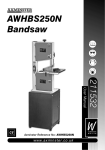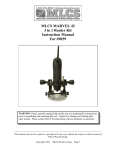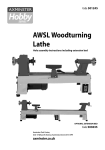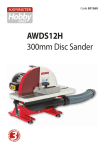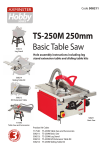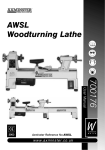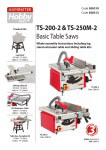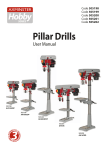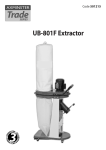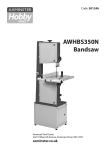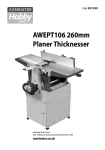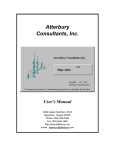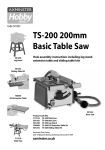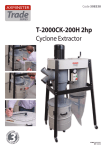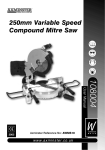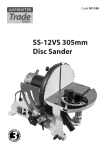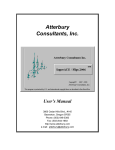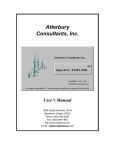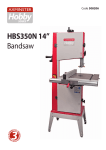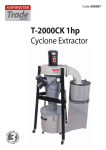Download HBS250N 10” Bandsaw - Axminster Power Tool Centre
Transcript
AXMINSTER Hobby SERIES HBS250N 10” Bandsaw Code 508204 Index of Contents Page No Index of Contents 02 Declaration of Conformity 02 What’s Included 03 General Instructions for 230V Machines 04-05 Specification05 Assembly06-07-08-09-10 Assembling the Saw 10-11 Illustration and Parts Description 11-12-13-14-15-16-17 Setting Up the Saw 18-19-20-21 Operating Instructions 21-22 Changing the Saw Blade 22-23 Changing the Blade Speed 24 Routine Maintenance 25 Parts Breakdown/List 26-27-28-29-30 Wiring Diagram 31 Declaration of Conformity Copied from CE Certificate Manufactured by Laizhou Chunlin Machinery Co. is in compliance with the following standards or standardisation documents in accordance with Council Directives The undersigned, (Roy Yongjun Xue) authorised by Laizhou Chunlin Machinery Co., Ltd. No. 1 Fuqian East Road 261400 Laizhou, Shandong PEOPLE’S REPUBLIC OF CHINA 2006/42/EC EN 61029-1:2009 EN 61029-2-5: 2002 Model Number: MJ3425 (Bandsaw) Warning Fully read manual and safety instructions before use Ear protection should be worn The symbols below advise that you follow the correct safety procedures when using this machine. Eye protection should be worn 2 Dust mask should be worn HAZARD Motor gets hot What’s Included Quantity Item Model Number MJ3425 1 No. 1 No. 1 No. 1 No. 1 No. 1 No. Bandsaw Bandsaw blade 1,790mm long 6” TPI (Mounted on in the saw but not tensioned) Saw Table Guide Fence Mitre Guide Table Insert (Code 508204) 1 No. Floor Cabinet comprising: 2 No. 2 No. 2 No. 2 No. 4 No. Top Supporting Plate Top Connecting Plate Side Connecting Plate Side Plate Rubber Feet 1 No. Packet containing: 30 No. 30 No. 30 No. 4 No. 1 No. 1 No. 1 No. 1 No. M6 x 12 Hex Bolt M6 Hex Nut M6 Washer M8x30mm Chamfered Hex Bolts and Washers 3mm- 5mm Hex Keys 8-10mm and 12-14mm Spanner Screwdriver Instruction Manual Having unpacked your saw and its accessories please dispose of any unwanted packaging properly. The cardboard packaging is biodegradable. 3 General Instructions for 230V Machines not use any solvents or cleaners as these may cause damage to any plastic parts or to the electrical components. Keep the work area as uncluttered as is practical, this includes personnel as well as material. Good Working Practices/Safety The following suggestions will enable you to observe good working practices, keep yourself and fellow workers safe and maintain your tools and equipment in good working order. Under no circumstances should CHILDREN be allowed in work areas. WARNING! KEEP TOOLS AND EQUIPMENT OUT OF THE REACH OF YOUNG CHILDREN It is good practice to leave the machine unplugged until work is about to commence, also make sure to unplug the machine when it is not in use or unattended. Always disconnect by pulling on the plug body and not the cable. Once you are ready to commence work, remove all tools used in the setting operations (if any) and place safely out of the way. Re-connect the machine. Primary Precautions This machine is supplied with a moulded 13 Amp. Plug and 3 core power cable. Before using the machine inspect the cable and the plug to make sure that neither are damaged. If any damage is visible have the tool inspected/repaired by a suitably qualified person. If it is necessary to replace the plug, it is preferable to use an ‘unbreakable’ type that will resist damage on site. Only use a 13 Amp plug and make sure the cable clamp is tightened securely. Fuse as required. If extension leads are to be used, carry out the same safety checks on them and ensure that they are correctly rated to safely supply the current that is required for your machine. Carry out a final “tightness” check e.g. guide fence, table tilt, etc., check that the ‘cutting path’ (in this case the path that the work piece will travel) is unobstructed. Make sure you are comfortable before you start work;balanced, not reaching etc. If the work you are carrying out is liable to generate flying grit, dust or chips wear the appropriate safety clothing, goggles, gloves, masks etc. If the work operation appears to be excessively noisy, wear ear-defenders. If you wear your hair in a long style, wearing a cap, safety helmet, hair net, even a sweatband, will minimise the possibility of your hair being caught up in the rotating parts of the tool. Likewise, consideration should be given to the removal of rings and wristwatches, if these are liable to be a ‘snag’ hazard. Consideration should also be given to nonslip footwear, etc. Work Place/Environment Make sure when the machine is placed that it sits firmly on the floor; that it does not rock and is sufficiently clear of adjacent obstacles so that cutting operations will not be impeded. Check you have adequate clearance both in front of and behind the machine when cutting long stuff. If you are liable to be processing unwieldy or awkward work pieces, it is suggested that you consider fastening the machine down to the floor. The machine is not designed for sub-aqua operation, do not use when or where it is liable to get wet. If the machine is set up in the open, and it starts to rain (unusual though this would be in U.K.), cover it up or move it into the dry. If the machine has got wet; dry it off as soon as possible with a cloth or paper towel. Do not use 230V a.c. powered machines anywhere within a site area that is flooded or puddled and do not trail extension cables across wet areas. Keep the machines clean; it will enable you to more easily see any damage that may have occurred. Clean the machine with a damp soapy cloth if needs be, do Do not work with cutting tools of any description if you are tired, your attention is wandering or you are being subjected to distraction. A deep cut, a lost fingertip or worse; is not worth it! Do not use this machine within the designated safety areas of flammable liquid stores or in areas where there may be volatile gases. There are very expensive, very specialised machines for working in these areas, THIS IS NOT ONE OF THEM. 4 General Instructions for 230V Machines Above all, OBSERVE…. make sure you know what is happening around you and USE YOUR COMMON SENSE. Check that blades are the correct type and size, are undamaged and are kept clean and sharp, this will maintain their operating performance and lessen the loading on the machine. Specification Code508204 ModelHBS250N RatingHobby Power 370W, 230V Blade Speed 660 & 960 m/min Blade Length 1,790mm Blade Width Min/Max 6mm (1/4”) to 13mm (1/2”) Max Width of Cut 245mm Max Depth of Cut 120mm Max Width of Cut with Fence 220mm Table Size 340 x 340mm Table Height on Stand 990mm Table Tilt -5° to +45° Wheel Diameter 250mm Dust Extraction Outlet 63mm Overall L x W x H 420 x 410 x 1,500mm Weight43.5kg Please read the Instruction Manual prior to using your new machine; as well as the operating procedures for your new machine, there are numerous hints and tips to help you to use the machine safely and to maintain its efficiency and prolong its life. Keep this Instruction Manual readily accessible for any others who may also be required to use the machine. 5 Assembly Your saw is packed in the box partially assembled. around the saw (open both sides of the box?) then “corner walk” the saw out of the box. If this is still awkward, split the top of the box, fold the box material flat on the floor and “wriggle” the saw off the cardboard. The best method of moving the saw is with a ‘hug’ lift through the neck of the saw, holding the saw back against your body and lifting by straightening your legs. Please make careful note of the positions of the various components if you have cause to disassemble whilst putting the machine together. Take all the easily removable items out of the box, tip the box up so that the base of the saw is to the ground; remove all the polystyrene packaging from Cabinet Assembly Step 1 Step 2 Support plate Rubber foot Base M6 x 12 bolts and washers Both side support plates assembled 6 Assembly Connecting plate Door Step 3 Lower hinge pin 7 Assembly Step 4 Side plate M6 x 12 Bolts Fit the remaining side and connecting plate using M6 x 12 nuts bolts and washers 8 Assembly Assembling the Saw remove the blade, taking care as it is manoeuvred clear of the guides and the safety guards. Lift the saw on to the completed cabinet and secure using the 4 No. M8x40 bolts. Insert the bolts through the base of the saw, through the floor stand and fit the washers and nuts on the underside. NOTE: If you are going to remove the blade, prior to this you must check and, if necessary, set the lower blade guide assembly about the blade. The assembly is mounted in a small housing that is bolted to the main frame. It is locked in position by a hex socket grub screw that is extremely difficult to access when the table is fitted. Check that the assembly is set evenly about the blade. The saw table can be fitted without removing the blade. However, if you would feel more comfortable not having to manoeuvre the table around the blade, remove the blade by opening the top and bottom covers release the tension on the blade by backing off the tensioning knob see fig 1 on page 11, and Two Man lift Step 5 When mounting the bandsaw, we strongly advise you get the assistance of another person because of the weight. 9 Assembly satisfactory, set the table flat and tighten the tilt mechanism. Fitting the saw table 1. Remove the table fence and fence guide rail, see figs D and E. 2. Manoeuvre the table carefully around the blade (if still fitted). Balance the table on the edge of the tilt housing. The securing bolt for the tilt mechanism (an M8x50 coach bolt) is pre-fitted into the tilt quadrant. Remove the butterfly nut and the washer and fit the tilt quadrant into the tilt housing. Ensure that the bolt is correctly inserted through the slot and that the little rib cast on the tilt housing corresponds to the groove in the tilt quadrant. Check that the square under the bolt head is correctly located in its recess in the casting and refit the washer and the butterfly nut, see figs A,B & C. C D Table insert A E 3. Replace the blade (if it has been removed), slipping it through the slot in the table, through the guards and the guides and over the wheels; apply some tension to the blade to hold it in place. B M8x50 coach bolt Tilt housing NOTE: Before tightening, check that the tilt mechanism functions correctly. If it doesn’t, something is probably slightly misaligned. Slacken off the butterfly nut, re-position the quadrant and try again. When everything is 4. Replace the table fence rail and butterfly nuts and refit the fence assembly, see figs D & E. Locate the guide fence and slot the clamp lever assembly over the table fence and press down guide fence clamping lever to lock the guide fence in place, see fig E. 10 Illustration and Parts Description Fig 01 Blade tensioning knob Upper door locking knob Upper blade guide height clamp Upper cover door Table fence Upper blade guide and guard Main saw frame Saw table ON/OFF button Mitre fence Guide fence rail Table insert Fence clamping lever Lower cover door Lower door locking knob Cabinet Off On ON/OFF buttons 11 Illustration and Parts Description Main saw frame The main body of the machine that all the other parts are mounted upon. Upper and lower cover doors The two doors that cover the upper and lower saw wheel compartments. There are interlocks fitted to both doors so that the machine cannot operate if either door is left open. Upper saw wheel The upper saw wheel is mounted on double bearings on an axle that is mounted to a tilting plate to provide the fore and aft tilt movement that controls the blade tracking. The tilting plate is hinged to a yoke. The extended ends of the hinge pin also act as guides in slots in a bracket mounted in the rear of the upper saw wheel compartment. The yoke is driven up or down allowing increasing or decreasing of the blade tension). The saw wheel is fitted with a rubber tyre to give better grip to the saw blade and smoother running. It also allows the blade to be tracked in the centre of the wheel; unlike the bad old days when the blade had to be tracked off the front edge of the wheel to safeguard the teeth. Blade tensioning knob The blade tensioning knob, at the top of the machine, has an anchored threaded tube connected to it. A bolt passing through the shoulder of the yoke is threaded into the tube. As the knob is turned, so the bolt (and the yoke) is moved up or down and tensions or de-tensions the blade. Upper blade guide and guard The upper blade guide assembly mounts the two side bearings and the rear thrust bearing that keep the blade stable (straight and untwisted) above the table during the sawing operation. The guard is an integral part of the guide mounting leg to which the guide assembly is bolted so it is always in place when the guide is raised or lowered to its working position. Upper blade The upper blade guide height clamp is a butterfly nut and coach bolt arrangement guide height that clamps through the guide mounting leg and the main clampsaw frame. So, loose it will allow the mounting guide leg to be moved up and down; tightened it will clamp the leg in position against the frame. Saw table, tilt The saw table is mounted on the tilt quadrant which is, in turn, mounted in the assembly and quadrant housing and secured via a coach bolt and butterfly nut arrangement. scale Loosening the butterfly nut allows the table to be tilted up to 45 degrees clockwise There is a hole in the frame under the table, into which a bolt with a pair of lock nuts could be fitted to act as a preset stop when bringing the table back to the level position. Without this bolt fitted the table can be tilted to 5 degrees anti-clockwise. There is a scale and pointer attached to the rear of the quadrant and the housing to measure the angle to which the table has been tilted. There is a slot machined in the table to accept the slide of the mitre fence. There is also a machined recess into which a Measuring Scale Decal is fitted. Saw table insert The saw table insert fits into the round recessed groove in the centre of the table. It not only fills the round void, it also supports the work piece below the saw in order to minimise ‘breakout’ from the saw cut. The table insert that is supplied is for general work and, as such, has a fairly wide slot to allow the fibre strands from general redwoods and whitewoods to be carried through by the saw blade. Alternative table inserts with much narrower slots should be made when carrying out very fine work, where the breakout must be kept to a minimum. 12 Illustration and Parts Description Fig 02 Tracking control knob and tracking control lock Upper blade guide height clamp Main saw frame Power cable Upper blade guard Saw table Tilt mechanism Motor Tilt mechanism clamp Dust extraction outlet Lower wheel mounting 13 Motor pivot clamping bolt Illustration and Parts Description Lower blade guide The lower blade guide assembly is mounted on the main saw frame below the table, it mounts two side guide bearings that help to keep the blade stable (straight and untwisted) below the table during the sawing operation. Guide fence The guide fence is mounted over the front and rear edge of the table. It is clamped in position by the lever handle protruding from the front edge of the guide. The clamping action is such that both the front and rear of the guide are clamped to the table, ensuring that the guide fence is held rigidly during the cutting operation. Table stabilising When the table was cast it was a pretty stable lump, however, weathering, bolt and butterflymachining, drilling and boring etc set up varying stresses in the table which, if nut given the opportunity, (like with a long slot cut across more than half its width) will cause the table to ‘move’. To counteract this possibility a small housing is machined at the front of the slot into which the stabilising bolt is fitted and clamped with the butterfly nut. This ensures that the two most vulnerable parts of the casting are clamped together in a single plane, to prevent warping and twisting (Unseen). Mitre fence The mitre fence slide can be engaged in the slot in the saw table, and acts as an X-feed device, which will enable any angle from right to 45 degrees left or right to be cut with the saw. Tracking control star knob The tracking control star knob, at the rear of the top compartment, is connected to a threaded rod that is engaged in a threaded hole in the mounting bracket of the upper saw wheel axle assembly. The end of the rod pushes against the lower end of the hinged tilting plate that carries the upper saw wheel axle. Driving the rod in or out will cause the plate to tilt, and by association, the upper saw wheel, thus enabling the blade to be ‘tracked’. The tilting plate is kept in contact with the end of the threaded rod by the tension on the saw blade, the downward ‘pull’. It should be self-evident therefore, that the blade can only be ‘tracked’ whilst it is in tension. Tracking control lock A butterfly nut that locks the tracking control in position once correct tracking has been established. Lower saw The lower saw wheel and integral pulley wheel is likewise mounted on double wheelbearings, onto an axle that is housed in an adjusting ‘box trap’ mounting. This box trap is used to set the Lower Saw Wheel to DATUM. It is the base parameter that the rest of the saw is set against. It is highly recommended that, except in the most dire of circumstances, you do not alter the factory setting. Motor clamping The drive belt is tensioned by turning the motor against a fixed point, pulling the bolt slotbelt tight and then locking the motor in position with its clamping bolt. During the turning operation the clamping bolt moves within the slot that is machined into the motor mounting flange plate. Dust extraction outlet An 80mm diameter dust extraction outlet. On/Off Button and switch shroud The On/Off buttons, controlling an NVR switch. The green ‘I’ is the ‘on’ button, the red ‘O’ is the off button. 14 Illustration and Parts Description Fig 03 Micro switch Upper saw wheel Saw guard clamp Saw Saw wheel brush Lower saw wheel Drive Belt Drive pulley 15 Illustration and Parts Description Fig 04 Tilt scale and pointer Fig 05 Quadrant housing Tilt mechanism clamp Guide fence Fence clamping lever Fig 07 Fig 04a Tilt quadrant Fig 06 Mitre fence Measuring scale Fore and aft clamping nut Rear thrust bearing Saw guard Guide bearing adjusting bolt Lateral adjustment clamping grub screws Upper blade guide assembly 16 Fig 08 Illustration and Parts Description Fig 09 Fig 10 Lower blade guide Rear thrust bearing Magnifying glass with index marker Fig 11 Fig 12 Fence rail butterfly nuts Saw wheel brush Fig 13 Fig 14 Table levelling stop bolt Blade guide assembly 17 Setting Up the Saw Fig 15 DISCONNECT THE SAW FROM THE MAINS SUPPLY! Blade Tensioning and tracking the blade Make sure both top and bottom blade guides are well clear of the blade. Tyre Open the front covers fully, giving good access to the top compartment of the saw and good visibility into the bottom compartment, see fig 03. For tracking the blade first adjust all bearing guides so that there well clear of the blade. Check that the blade is sitting approximately in the middle of the wheels, see fig 15. Fig 16 Apply some tension to the blade by turning the tensioning wheel clockwise. Spin the top wheel by hand, and check that the blade remains centrally on the tyre, see fig 16. If it does not, loosen the tracking control lock and adjust the tracking by turning the tracking control at the rear of the upper saw wheel compartment, see fig 17. Viewed directly onto the tracking control wheel, turning clockwise should cause the blade to track to the rear of the tyre, anti-clockwise to the front, (DO NOT make large adjustments). Spin the top wheel again, check again. Continue until the blade tracks in the centre of the tyres with no appreciable to and fro movement. Tension the blade fully. A side ways push of about 7-8 lbs(3+kgs) in the middle of the blade should allow a 1/4” (6.5mm) distension. Check the tracking again, adjust if necessary. Check that the drive belt is tensioned correctly. If it is slack, apply tension as follows:- loosen the pivot bolt on motor mounting flange plate and turn the motor away from the saw wheel pulley. When the belt is under tension, tighten the pivot clamping bolt to hold the motor in position, see fig 18. Do not overtighten. Fig 17 Tracking control knob Connect the power to the machine. Stand clear and start the saw, check that the saw is running smoothly, (no thumps, bumps,knocking or excessive vibration) and the blade appears to be tracking correctly (in one place). You can check this by holding a marker, e.g. a pencil, close to the back of the blade (approach from the back of the blade only) and check that the gap remains constant. If it doesn’t, adjust the tracking until it does. If you adjust the tracking with the saw Fig 18 Pivot clamping bolt 18 Setting Up the Saw running, make very small adjustments and wait for the saw to react before you adjust again, sometimes the reaction is not instantaneous. Once you are satisfied that the tracking is correct switch the machine off and allow it to run to a stop. Retighten the tracking control lock. DISCONNECT THE SAW FROM THE MAINS SUPPLY! that the blade is perpendicular to the table. If it is not, try resetting the table. If it is still not correct, loosen the locking nut and adjust the bolt until perpendicularity is achieved, see fig 19. Tighten the lock nut and then re-check. When you are satisfied that the table is set correctly, check that the pointer of the tilt gauge reads zero, if not, adjust it, see fig 21. Fig 21 Checking the table is square If the preset table stop has been fitted, proceed as follows:- A B Loosen the butterfly nut clamping the tilt mechanism, see fig 04, and turn the table hard against its stop. This is a bolt with a lock nut screwed into the underside of the table, see fig 19, the head of the bolt has a rubber foot that acts as a stop when it strikes the machine frame. Tighten the butterfly nut. Fig 19 Tilt pointer (A) and tilt gauge (B) Setting the Fence Locking nut To make sure the guide fence is at 90˚line up the guide fence with the edge of the table’s ‘T’ slot, see fig 22. If you find that the fence is out of alignment follow the steps on the next page: Fig 22 Fence Make sure the upper blade guide is raised as high as possible. Place a square on the table and move it up against the blade (behind the teeth), see fig 20.Check Fig 20 ‘T’ slot 19 Continues Over... Setting Up the Saw • Clamp down the fence by pushing the locking lever down. Fig 25 A • Remove the fence end cover to access the Hex screws, see fig 23. • Loosen the 4 Hex screws that secures the fence rail and adjust until the fence is in alignment with the ‘T’ slot, then re-tighten the bolts, see fig 23-24. • Replace the fence cover and move the fence assembly to the left side of the table. • Replace the mitre fence. Fig 26 Fig 23 B Hex screws 1mm behind the blade Cover Fig 24 Fig 27 C Setting the Blade Guides DISCONNECT THE SAW FROM THE MAINS SUPPLY! Lower the upper blade guide to approximately 1 1/2”(38mm) above the table. Clamp in place. Remove the table insert. Loosen the nut (A) holding the guide assembly in place, see fig 25, adjust the fore and aft position so that the leading edges of the side guide bearings are approximately 2mm behind the gullets of the saw blade. Re-tighten the nut, see fig 25. Loosen the cap head bolt (B) that clamps the rear thrust bearing in position and adjust the thrust bearing to approximately 1mm behind the blade, re-tighten the bolt, see fig 26. The blade should line 20 Setting Up the Saw up with the centre of the thrust bearing, if not loosen the two grub screws (C) and move the upper blade guide assembly in until correct, see fig 27. Retighten the grub screws. Loosen the two cap head bolts holding the guide bearings (D), move to approximately 0.5mm from each side of the blade. Re-tighten the bolts. NOTE: A five pound note is approximately 0.5mm thick, slide a note between the blade and guide bearing until the guide bearing is set to the correct thickness. Re-tighten the bolts (D), see fig 28. Repeat for the other guide bearing. guide assembly. Rotate the top wheel by hand, at this point. None of the bearings should come into contact with the blade-only when in use. Re-tighten the nut. Adjust the lower side blade guides (D) and set them similarly to the upper guides, using an Hex key to Cap head nut Fig 29 Lower guide bearing Fig 28 Rear thrust bearing D Gently push the blade back against the thrust bearing (use a scrap of wood) and check that the side bearings are still behind the teeth of the blade. Loosen the nut holding the lower blade guide assembly in place and position similarly to the upper release and tighten the clamping bolts, see fig 29. When all adjustments have been made, recheck that when the blade is pressed back against the thrust bearing, both the upper and lower side guides are still behind the teeth of the saw. When all adjustments are complete replace the table insert. Re-connect the power, switch the saw on, allow to run for several minutes, check that the blade is still tracking correctly, there is no excessive vibration, etc. Switch off. The saw is ready to be used. Operating Instructions 1. Make sure you have read and fully understood the general instructions and safety precautions that are printed in the preceding pages of this manual. 2. Before connecting the machine to the supply; check the tool for obvious signs of damage, paying particular attention to the plug and the power cable. Rectify or have rectified any damage you discover. Check that the blade you are using is the correct one for the job in hand. Change the blade if necessary. Check the blade is not damaged; is clean, sharp, tracks properly and is correctly tensioned. 3. Set the upper blade guide to approximately 12mm (1/2”) above the height of the work piece. 4. Check, especially on site, that there are no foreign objects e.g. old nails, screws, small stones etc. embedded in the material you are about to cut. 5. Check that all accessories, tools etc., that have been used to set the machine up, are removed and set carefully aside or stowed away correctly. 6. Ensure the machine is switched off. Plug the power cable into a correctly rated switched socket outlet. If extension leads are being used, check these for damage, do not use if damaged; if you are working outside, check that any extension cables in use are rated for outside work. Switch on. Allow the saw to run up to speed. 7. Make sure that the material you are about to cut is within the machine capacity, and the cut you are about to make is within the blades’ capabilities. e.g. Do not try to cut a 1” radius curve using a 5/8” blade. 21 Continues Over... Operating Instructions 8. Make sure the blade is not in contact with the material when you start the saw. Start the cutting operation. find something to use as a sacrificial carrier and mount the work piece on it with double sided tape, or similar. Do not try to cut too quickly; the correct cutting speed, if one could be so precise, would never see the blade pushed back against the thrust bearing. The saw would cut and clear the saw line at the rate the work piece was fed into it. If you notice that you require more and more pressure to effect the cut, and the blade is in continual contact with the thrust bearing, the chances are the blade is becoming blunt. Check and change if necessary. 12. Remember to check the blade tension after a new blade has been ‘working’ for 30-60 mins. The blade will ‘stretch’ slightly when new. Do not let go of the work piece; if you have to change your grip, make sure one hand is holding the material at all times. 13. Do not release the tension on the saw blade when work is complete. The blades and the main saw frame do not respond kindly to frequent large changes in stress and tension. Only release the tension to change the blade or if the blade is to be removed because the machine is to be ‘mothballed’ for a lengthy time period. The blade in tension over a long period of non-use will cause the tyres to develop ‘flat’ spots. Open the saw cut, either by pulling apart or driving a wedge in close to the back 9. If you are cutting long pieces of material think about sawing cutouts (i.e. a saw cut from the edge of the material to the saw line) along the saw line so that you can discard the off cuts as you progress down the saw line. 10. Observe the old woodworkers’ adage of never allowing your hand/fingers within one handbreadth of the blade. 11. If you have to cut very small pieces of material, arrange or manufacture some form of ‘shoe’ to carry the timber. If the work piece is exceptionally small, WARNING! IF THE SAW JAMS! Switch off immediately. of the blade. Try to “wriggle” the blade free of the saw. If this is not possible; check that the saw is free in the cut, start the saw, allow it to run up to speed and ‘cut out’ as quickly as possible. The removal of the ‘off cut’ may well prevent the saw jamming again if you resume the original cut. Changing the Saw Blade Blade tensioning knob DISCONNECT THE SAW FROM THE MAINS SUPPLY! Fig 30 Put the table back to the level position if it has been tilted. Set the upper blade guide assembly approximately midway in the throat. Open the top and bottom covering doors. Remove the fence and guide rail and place safely aside. Slacken the blade tension by turning the blade tensioning wheel anti-clockwise, until the blade can be easily slipped off the wheels, see fig 30. Remove the blade carefully, “wriggling” it clear of the upper blade guard and out through the slot in the table. NOW is an excellent time to clean out the interior of the machine; remove the impacted ‘crud’ from the tyres, apply a little light oil to the screw threads of the blade tensioner and the tracking control. The pivots and the slides of the top wheel mounting assembly could likewise be lightly oiled. 22 Changing the Saw Blade If you are fitting a new blade; it will have been supplied to you “folded”, bound together in this configuration with tape or tie wrap. Also check the blade did not “unfold” inside out. i.e. looking at the right side front of the loop, the teeth should be on the front of the blade, and pointing down. If you can’t arrive at this view, turn the blade inside out from its current position and look again. Note: Be very cautious when you “unfold” the blade; it tends to ‘spring’ open, blade and teeth going everywhere. MAKE SURE THE BLADE TEETH ARE POINTING DOWN! Open up all blade guides so that they are clear of the blade. Hold the blade approximately midway on either side of the loop and feed into the table slot. When you get to the table insert cutout void, work the left side of the loop into the slot in the guard in the neck of the main saw frame. “Wriggle” the right hand side of the blade through the guard on the upper blade guide assembly. Ease the blade over the wheels and locate the blade in both the upper and lower blade guides, see fig 31. Apply some tension to the blade. Turn the top wheel by hand to ensure the blade will not skip off the wheels and the blade is travelling in the blade guides, see fig 32. Apply a little more tension and check by once again spinning the upper saw wheel by hand. Loosen the upper blade guide clamp and set the upper blade guide assembly so that the top of the blade guide is level with the centre of the top drive wheel, see fig 33. Re-tighten the clamp. When you are sure that the blade is “ON” and stable, re-fit the fence rail and fence. Now carry out the procedures as detailed in “Setting up the Saw”. Fig 32 Fig 31 Fig 33 Blade guide Blade 23 Changing the Blade Speed DISCONNECT THE SAW FROM THE MAINS SUPPLY! WARNING! BE VERY CAREFUL WHEN MOVING THE BELT NOT TO TRAP YOUR FINGERS! The bandsaw drive pulley has two speed positions, see fig 37. To change the speed from 600 to 960m/minute, follow the instructions below. NOTE: Make sue the drive belt is not tensioned to tightly which will cause the belt to get hot. Open the upper and lower doors, see fig 34 and release the tension on the belt by turning the Hex Fig 36-37 Fig 34 Drive pulley groove bolt (B) counter-clockwise, see fig 38. Release the motor pivot clamping bolt (A) and lifting the motor up, see fig 35. Tighten the bolt to hold the motor in place, reposition the belt as shown in figs 36-37, NOTE: Make sure the belt is seated correctly in one of the drive pulley grooves. With the belt repositioned, loosen the clamping bolt and push the motor back down and secure in position. Re-tension the belt, turn the Hex bolt (B) clockwise enough to prevent the belt from slipping when in operation, but not tight to cause the belt to get hot, see fig 38. 960m/min 600m/min Fig 38 Fig 35 B A 24 Drive belt tensioning bolt (B) Routine Maintenance Daily Monthly • Keep the machine clean. • Check the saw blade for missing teeth and cracks, see fig 39. • Spray oil the bare metal surfaces. • Open the lower and upper door and check the condition of the tyres & the drive belt, see figs 39-40. Weekly • The pivots and the slides of the top wheel mounting assembly and the captive stub axle of the belt tensioner in its slot could likewise be lightly oiled. • Using an air line (wearing goggles) blow out the motor casing. • Open the top & bottom wheel covers and clean out all saw dust. • Clean impacted ‘crud’ from the tyres, apply a little oil to the screw threads of the blade and drive belt tensioners. DO NOT USE OIL near the belt. Fig 39 a Clean out impacted ‘crud’ & saw dust b Fig 40 c • Check for missing teeth (a) • Check the condition of the tyres (b) • Check the condition of the drive belt (c) Clean out impacted ‘crud’ & saw dust 25 Oil Parts Breakdown/List 26 Parts Breakdown/List NO. Description Q’TY 35 Washer ø4 8 1 Bandsaw rame 1 36 Knob 1 2 Upper door 1 37 Blade guard 1 3 Lower door 1 38 Roller guide carrier extrusion 1 4 Upper wheel 1 39 Nut M4 4 5 Bearing ball 80100 4 40 Carriage bolt M8×20 3 6 Wing nut M8 1 41 Washer 1 7 Pan head tapping screw 4 42 Mount blade guide 1 8 Ring 2 43 Washer ø8 3 9 Bearing bolt upper 1 44 Hex nut M8 5 10 Wheel carrier bracket 1 45 Guide support upper large 1 11 Washer 3 46 Hex socket set screw M6×10 7 12 Hex nut 1 47 Upper guide shaft 1 13 Semicircle head screw M5×8 2 48 Hexagon screw 6 14 Washer ø5 2 49 Bearing ball 80026 6 15 Shaft mount 1 50 Washer ø5 6 16 Carriage bolt 1 51 Adjusting shaft 4 17 Blade tensioner 1 52 Mount shaft 2 18 Tension rod 1 53 Tension angle 1 19 Hex nut M5 2 54 Bolt guide plate 1 20 Screw 2 55 Lower guide shaft 1 21 Hex nut M4 2 56 Retainer 1 22 Washer ø4 2 57 Hexagon nut 1 23 Hex nut M4 2 58 Carriage bolt M6×16 4 24 Screw 1 59 Hexagon nut M6 12 25 Knob 1 60 Hex screw M6×25 4 26 Screw 1 61 2 27 Knob 1 Hex socket head cap screw M8×30 28 Leaf spring 2 62 Belt 1 29 Lamella plug black 1 63 Bearing bolt lower 1 64 Motor 1 65 Motor pulley 1 66 Table trunnion lower 1 67 Semicircle head screw M4×30 4 68 Lower guide mount 1 30 Knob 1 31 Hex screw M6×12 10 32 Washer ø6 20 33 Safety switch 2 34 Wing nut 2 27 Continues Over... Parts Breakdown/List 69 Pin guide seat 1 86 Blade 1 70 Lower guide body 1 87 Pan head cross screw 2 71 Table 1 88 Switch 1 72 Table insert 1 89 Rubber belt 2 73 Rubber washer 1 90 Handle 1 74 Carriage bolt M6×30 1 91 Washer 1 75 Glide piece 1 92 Mitre gauge 1 76 Table trunnion upper 1 93 Screw 1 77 Pointer 1 94 Pointer 1 78 Pan head tapping screw 1 95 Guide plate 1 79 Lower wheel 1 96 Screw 1 80 Ring 4 97 Semicircle head screw M6×20 8 81 Ring -retaining 2 98 Washer ø6 16 82 Spacer bushing 1 99 Hinge plate 4 83 Brush strip 1 100 8 84 Carriage bolt 1 Countersunk head screws M6X16 85 Hex nut 1 101 Hinge 4 102 Nut M6 8 28 Parts Breakdown/List GUIDE FOR MJ3425 10” BAND SAW WORKING TABLE PART NO Dl DESCRIPTION Guide plate QTY Dll Side guide plate 1 1 D12 Pallet 1 D2 Cap screw M6X12 2 D13 Washer 6 3 D3 Washer 6 4 D14 Cap screw M6X16 3 D4 Side plastic insert 2 D15 Bearing 1 D5 Plate 1 D16 Shaft 1 D6 Sliding base 1 D17 Washer 5 1 D7 U clamp 1 D18 Nut M5 1 D8 Locking bar 1 D19 Locking nail 1 D9 Locking handle 1 D20 Photo scope 1 D10 Butterfly bolt M6X14 2 D21 Ring 1 29 Parts Breakdown/List PART NO. DESCRIPTION QTY B8 Rubber foot 4 B7 Side connecting plate 2 B6 Side plate 2 B5 Hex bolt M6x12 36 B4 Hex nut M6 36 B3 Washer 6 72 B2 Top supporting plate 2 B1 Top connecting plate 2 30 Wiring Diagram 31 The Axminster guarantee is available on Hobby, Trade, Industrial, Engineer, Air Tool & Axcnc Technology Series machines It’s probably the most comprehensive FREE guarantee ever- buy with confidence from Axminster! So sure are we of the quality, we cover all parts and labour free of charge for three years! • Look for the icon and put your trust in Axminster • No registration necessary - just keep your proof of purchase • Optional Service Plan for Industrial Series machinery Great value & easy-to-use, perfect for use at home Solid, reliable machines designed for daily use Top performers with class leading features and build quality for use in busy workshops Quality, precision machines for the workshop or education Small machines for the home engineer Compressors and tools for home or workshop use; durable and great value Free Three Year Guarantee on Axminster Hobby, Trade and Industrial Series woodworking and engineering machines, Axminster Air compressors and Air Tools, and bench top grinders - no registration necessary just proof of purchase. We will repair or replace at our discretion and will collect only from a UK mainland address, irrespective of the original delivery address. The Guarantee assumes that you have bought the correct machine for the required operation, in accordance with our guidelines; have operated and maintained it in accordance with the instruction manual; and that all cutting machines will be used with a blade which is sharp and serviceable at all times. It does not cover consumable items purchased with the original product, including original blades or abrasives. Precision CNC machines for industry and education Normal wear and tear; misuse, abuse and neglect are excluded and the machine should not have been modified in any way. Please do not attempt to service the product without first contacting us; we are happy to guide you but failure to do so may invalidate the guarantee. The Guarantee is transferable from owner to owner in the first three years but you must have original proof of purchase. Should we need to replace a machine in the first three years the guarantee will still continue to be effective from the original purchase date. Full Terms and Conditions can be found at axminster.co.uk/terms This guarantee does not affect your statutory rights. For more information visit axminster.co.uk/3years Please dispose of packaging for the product in a responsible manner. It is suitable for recycling. Help to protect the environment, take the packaging to the local recycling centre and place into the appropriate recycling bin. Only for EU countries Do not dispose of electric tools together with household waste material. In observance of European Directive 2002/96/EC on waste electrical and electronic equipment and its implementation in accordance with national law, electric tools that have reached the end of their life must be collected separately and returned to an environmentally compatible recycling facility. Axminster Tools & Machinery Ltd Weycroft Avenue, Axminster, Devon EX13 5PH axminster.co.uk
































